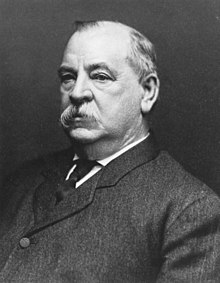📖 Presidential Profile
Comprehensive overview of leadership, policies, and historical significance
📋 Biography & Political Journey
The Honest Politician’s Rise to Power
Grover Cleveland emerged from relative obscurity as Buffalo’s mayor to become one of the most principled presidents in American history. His rapid political ascent—from mayor to governor of New York to president within three years—was fueled by his reputation for uncompromising honesty and reform. Cleveland’s motto “A public office is a public trust” became synonymous with his administration’s approach to governance.
Cleveland’s first presidency (1885-1889) was marked by his fierce independence and willingness to challenge both political parties. He vetoed more bills than any president before him, earning the nickname “The Veto President.” His commitment to civil service reform and opposition to political patronage made him enemies within his own Democratic Party but earned widespread public respect.
Economic Challenges and Conservative Principles
Cleveland’s second presidency (1893-1897) coincided with the Panic of 1893, one of the worst economic depressions in American history. His response reflected his conservative fiscal philosophy: he opposed government intervention in the economy and maintained that federal relief programs would weaken American character. Cleveland believed that economic hardship, while painful, was necessary for long-term economic health.
The president’s handling of the depression included repealing the Sherman Silver Purchase Act and maintaining the gold standard, decisions that alienated many in his own party. His partnership with financier J.P. Morgan to maintain federal gold reserves sparked controversy but prevented a complete financial collapse. “Though the people support the government, the government should not support the people,” Cleveland declared, articulating his philosophy of limited federal intervention.
International Relations and Monroe Doctrine
Cleveland’s foreign policy demonstrated American growing confidence on the world stage. His handling of the Venezuelan Boundary Dispute with British Guiana in 1895 marked a significant assertion of the Monroe Doctrine. Cleveland’s ultimatum to Britain—demanding arbitration of the dispute—represented the first time an American president had seriously challenged European colonial powers in the Western Hemisphere.
The president also opposed American territorial expansion, particularly regarding Hawaii. Despite significant pressure from expansionist Republicans and business interests, Cleveland withdrew the Hawaiian annexation treaty from Senate consideration, arguing that the overthrow of Queen Liliuokalani had been improper and that annexation would violate American principles of self-determination.
The Pullman Strike and Labor Controversies
Cleveland’s most controversial decision involved his response to the Pullman Strike of 1894. Despite objections from Illinois Governor John Peter Altgeld, Cleveland sent federal troops to break the strike, claiming that mail delivery had been disrupted. His action split the Democratic Party and alienated organized labor, contributing to his party’s devastating losses in the 1894 midterm elections.
The president’s justification—that he was protecting federal property and ensuring mail delivery—masked broader concerns about labor radicalism and social disorder. Critics argued that Cleveland had sided with corporate interests against working people, undermining his reputation as a champion of the common man. The incident highlighted the tensions between Cleveland’s constitutional principles and the practical challenges of industrial America.
The Secret Surgery and Presidential Health
One of the most remarkable episodes of Cleveland’s presidency involved a secret cancer surgery performed aboard a yacht in 1893. Concerned that news of his illness might worsen the ongoing economic crisis, Cleveland underwent surgery to remove a malignant tumor from his mouth while cruising on his friend’s yacht, the Oneida, in Long Island Sound.
The operation was performed by a team of doctors led by Dr. Joseph Bryant, using only ether as anesthesia. The surgery was so secretive that even Cleveland’s wife was unaware of its extent. When rumors of the operation surfaced, Cleveland’s administration denied them, and the full story didn’t emerge until 1917, nine years after his death. The president’s dedication to maintaining public confidence, even at great personal risk, exemplified his commitment to presidential duty above personal comfort.
Humor & Jokes
Gold Standard Defense
Cleveland defended the gold standard so fiercely, you'd think he personally owned Fort Knox. Monetary…
Read More →Greatest Wins
⚖️ Civil Service Reform and Merit System Expansion
Cleveland dramatically expanded civil service protections, reducing political corruption and establishing professional standards in government…
Read More →Epic Fails
🏥 Secret Cancer Surgery Aboard Presidential Yacht
Cleveland underwent secret cancer surgery in 1893 while the nation faced economic crisis, deceiving the…
Read More →